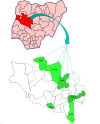Effect of community-based intervention on improving access to treatment for sick under-five children in hard-to-reach communities in Niger State, Nigeria
- PMID: 31263548
- PMCID: PMC6594663
- DOI: 10.7189/jogh.09.010803
Effect of community-based intervention on improving access to treatment for sick under-five children in hard-to-reach communities in Niger State, Nigeria
Abstract
Background: Access to prompt and appropriate treatment is key to survival for children with malaria, pneumonia and diarrhoea. Community-based services are vital to extending care to remote populations. Malaria Consortium supported Niger state Ministry of Health, Nigeria, to introduce and implement an integrated community case management (iCCM) programme for four years in six local government areas (LGAs). The objective was to increase coverage of effective treatment for malaria, pneumonia and diarrhoea among children aged 2-59 months.
Methods: The programme involved training, equipping, ongoing support and supervision of 1320 community volunteers (CORPs) to provide iCCM services to their communities in all six LGAs. Demand creation activities were also conducted; these included community dialogues, household mobilization, sensitization and mass media campaigns targeted at programme communities. To assess the level of changes in care seeking and treatment, baseline and endline household surveys were conducted in 2014 and 2017 respectively. For both surveys, a 30×30 multi-stage cluster sampling method was used, the sampling frame being RAcE programme communities.
Results: Care-seeking from an appropriate provider increased overall and for each iCCM illness from 78% to 94% for children presenting with fever (P < 0.01), from 72% to 91% for diarrhoea cases (P < 0.01), and from 76% to 89% for cases of cough with difficult or fast breathing (P < 0.05). For diagnosis and treatment, the coverage of fevers tested for malaria increased from 34% to 77% (P < 0.001) and ACT treatments from 57% to 73% (<0.005); 56% of cases of cough or fast breathing who sought care from a CORP, had their respiratory rate counted and 61% with cough or fast breathing received amoxicillin. At endline caregivers sought care from CORPs in their communities for most cases of childhood illnesses (84%) compared to other providers at hospitals (1%) or health centres (9%).This aligns with caregivers' belief that CORPs are trusted providers (94%) who provide quality services (96%).
Conclusion: Implementation of iCCM with focused demand creation activities can improve access to quality lifesaving interventions from frontline community providers in Nigeria. This can contribute towards achieving SDGs if iCCM is scaled up to hard-to-reach areas of all states in the country.
Conflict of interest statement
Competing interests: The authors completed the Unified Competing Interest form at www.icmje.org/coi_disclosure.pdf (available upon request from the corresponding author), and declare no conflicts of interest.
Figures





References
-
- World Health Organization. 2018. World Malaria Report 2018. Geneva: World Health Organization; 2018. Available: http://apps.who.int/iris/bitstream/handle/10665/275867/9789241565653-eng... Accessed: 28 November 2018.
-
- World Health Organization and UNICEF. Ending preventable child deaths from pneumonia and diarrhoea by 2025—the integrated Global Action Plan for Pneumonia and Diarrhoea (GAPPD). Geneva/New York: WHO/UNICEF; 2013.
-
- National Population Commission (NPC), Marco O. Nigerian Demographic and Health Survey 2008.Calverton, MD: National Population Commission (NPC) and ORC Marco; 2009.
-
- Christopher JB, Le May A, Lewin S, Ross D. Thirty years after Alma-Ata: a systematic review of the impact of community health workers delivering curative interventions against malaria, pneumonia and diarrhea on child mortality and morbidity in sub-Saharan Africa. Hum Resour Health. 2011;9:27–38. doi: 10.1186/1478-4491-9-27. - DOI - PMC - PubMed
MeSH terms
Grants and funding
LinkOut - more resources
Full Text Sources
Medical
